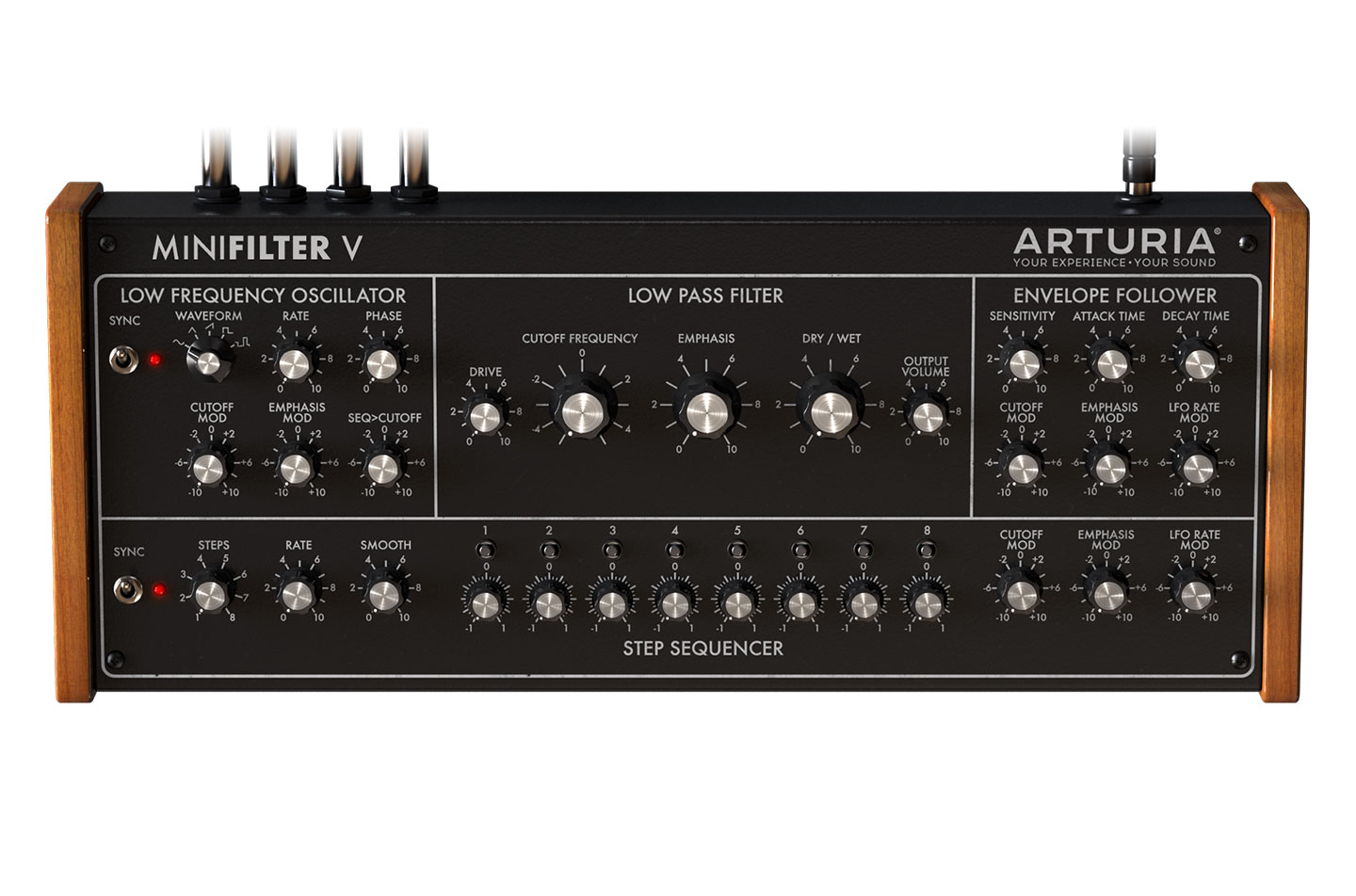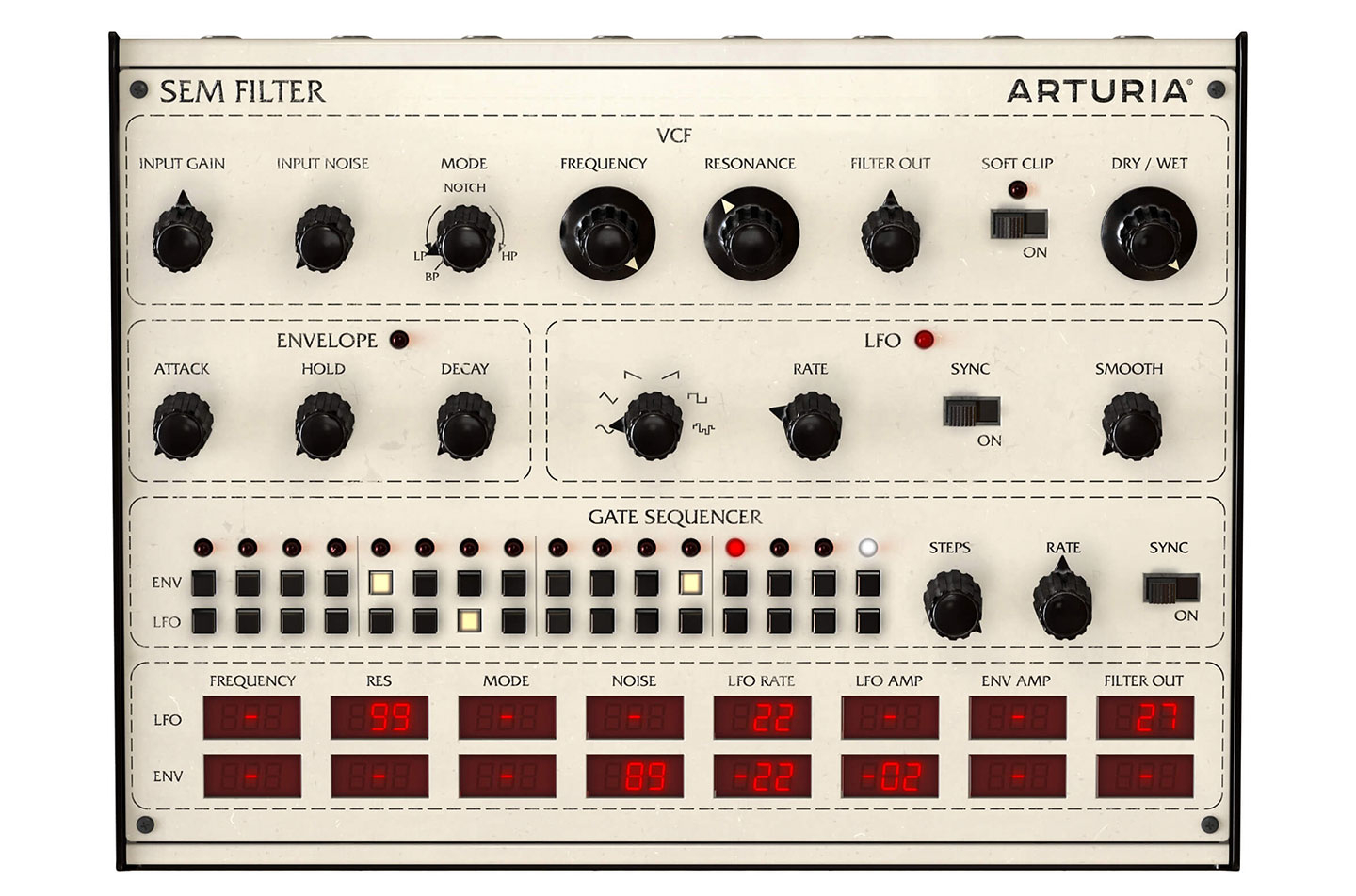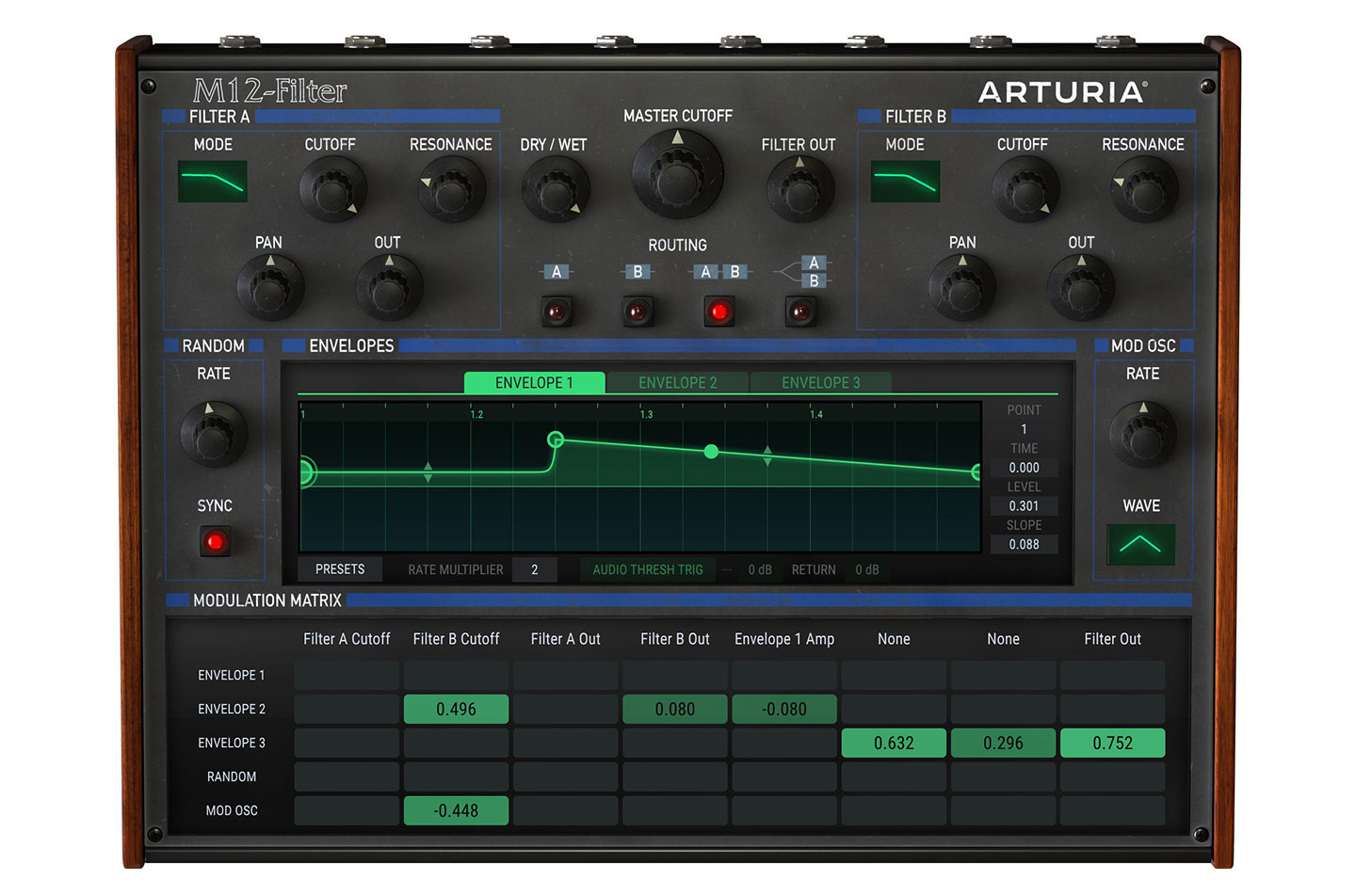- Arturia give you the chance to use Moog and Oberheim filters anywhere in your production process.
- Beginning with their first release way back in 2003, Arturia's software products have all shared a theme: they're virtual recreations of real-world instruments. Using proprietary "True Analog Emulation" technology, Arturia's development teams work to mirror the behaviour of synthesisers and other analogue keyboards in detail, with the end goal being a sound as close to the original as possible. They've enjoyed success with this model for over 15 years, which is why it was especially surprising when last month they announced they would be adding a new category to their software portfolio—effects. The first of these offerings includes a pair of bundles, peculiarly named "3 Filters You'll Actually Use" and "3 Preamps You'll Actually Use". I was most intrigued with the collection of filters, so I put them through the usual tests to see how they fared.
The 3 Filters collection includes TAE-modelled reproductions of three of Arturia's most popular instruments: the SEM V, the Mini V and the Matrix-12 V. These new plug-ins are called SEM-Filter, Mini-Filter and M12-Filter, respectively. If the name Mini-Filter rings a bell, that's because it's actually the same plug-in offered for free by Arturia for a limited period during the 2016 holiday season. By including it here, Arturia is following a model similar to Native Instruments, another giant in the music software industry. You may recall from one of our recent reviews that NI's recent Mod Pack bundle was also made up of three effects, one of which was a formerly-free holiday giveaway (Phasis).
If you took advantage of Arturia's original giveaway and got used to MiniFilter's design, you will likely have no trouble getting your head around the workflow of its bundled siblings. This is because Arturia kept to the same general foundation for each. Naturally, the heart of each plug-in is a filter (or two), which is complemented by a set of modulation sources to infuse a sense of movement or rhythmic patterns to your filtered signal. In the case of Mini-Filter, this is based on the 24dB/oct ladder filter found on the legendary Minimoog. Arturia also included a Drive knob allowing you to replicate the characteristic overdrive made possible on the original by feeding the output of the filter back into itself. For modulation, Mini-Filter gives you three sources to work with: an LFO with four waveforms and sample & hold, an envelope follower and a step sequencer with up to eight steps available. As one would expect, each of these modulators can be assigned to control the cutoff and resonance (here known as "emphasis" following Bob Moog's original terminology) in both positive and negative amounts. Things can get a bit more complex however, thanks to some inter-modulation routings that let you control the LFO rate using the envelope follower, and the cutoff mod amount of the sequencer using the LFO. On paper, with its fixed-mode lowpass filter and lack of a modulation matrix, MiniFilter is the most limited of the three plug-ins on offer here. Still, I was enamoured with the sound of the filter and pleased at how much I could achieve with this unassuming effect.
SEM-Filter on the other hand, is built upon the foundation of Tom Oberheim's classic Synthesiser Expander Module (SEM). One of the most lauded aspects of the SEM was its 12dB/oct state-variable filter, which allows you to smoothly crossfade from lowpass to notch to highpass. You can also flick a switch to get a bandpass filter. Arturia kept that original design intact but added a noise oscillator as well as its own set of controls that can all be used to add warmth, grit, and distortion to your signal before the filtering begins. At first glance, the modulation options on the SEM-Filter seem to be the nearly identical to Mini-Filter, with one LFO, an envelope follower and a step sequencer prominently displayed on the plug-in UI in the spartan style of the original SEM. Here however, the sequencer is not a modulator that can be assigned to other parameters. It serves instead to trigger the envelope and LFO at each highlighted step. Hence, the SEM-Filter excels at rhythmic filter patterns that can be easily programmed using the combination of the sequencer and the handy modulation matrix, which lets you freely assign the LFO and envelope to eight different destinations.
It seems only fitting that the most complex plug-in of the bunch is based off of the legendary Oberheim Matrix-12, a synthesiser that featured a previously unimaginable feature set when it was released. Where the other plug-ins shared an emphasis between raw sound and modulation, the M12-Filter concentrates almost completely on the latter. This is the mad scientist in the room with the jocks, and the heart of its UI contains five different advanced modulation sources that can act on a pair of Matrix-12 filters. From left to right you find a random signal generator, three flexible envelope generators and a modulation oscillator with a range wide enough to serve as both an LFO and and an audio-rate modulator. The envelope generators are the same as those found on the Matrix-12 V plug-in, which let you design your own shapes consisting of up to 16 points with adjustable levels, times and slopes. Using the available trigger options, these can serve as LFOs, step sequencers or an envelope triggered by incoming audio. When compared to the envelope generators, the random source and modulation oscillator feel a bit limited with their one-knob design (adding a smoothing parameter to the random source would have made a huge difference). However, when you take into account the advanced mod matrix and the fact that the filters can be routed four different ways, the amount of sound design potential available here is undoubtedly impressive.
At the end of the day, I found little to complain about with the 3 Filters. Each offers predictable host and MIDI-assigned automation capabilities, but one thing that seemed to be conspicuously missing is the ability to trigger the envelope generators using incoming MIDI notes. Since the plug-ins are VST3 compatible, Arturia could also take advantage of the ability to support sidechain processing in these plug-ins. Finally, as a fan of really slow LFOs, I would have preferred to see a setting longer than the four bars available.
Ratings:
Cost: 4.0
Versatility: 4.5
Ease of use: 4.1
Sound: 4.7
 SEM-Filter on the other hand, is built upon the foundation of Tom Oberheim's classic Synthesiser Expander Module (SEM). One of the most lauded aspects of the SEM was its 12dB/oct state-variable filter, which allows you to smoothly crossfade from lowpass to notch to highpass. You can also flick a switch to get a bandpass filter. Arturia kept that original design intact but added a noise oscillator as well as its own set of controls that can all be used to add warmth, grit, and distortion to your signal before the filtering begins. At first glance, the modulation options on the SEM-Filter seem to be the nearly identical to Mini-Filter, with one LFO, an envelope follower and a step sequencer prominently displayed on the plug-in UI in the spartan style of the original SEM. Here however, the sequencer is not a modulator that can be assigned to other parameters. It serves instead to trigger the envelope and LFO at each highlighted step. Hence, the SEM-Filter excels at rhythmic filter patterns that can be easily programmed using the combination of the sequencer and the handy modulation matrix, which lets you freely assign the LFO and envelope to eight different destinations.
SEM-Filter on the other hand, is built upon the foundation of Tom Oberheim's classic Synthesiser Expander Module (SEM). One of the most lauded aspects of the SEM was its 12dB/oct state-variable filter, which allows you to smoothly crossfade from lowpass to notch to highpass. You can also flick a switch to get a bandpass filter. Arturia kept that original design intact but added a noise oscillator as well as its own set of controls that can all be used to add warmth, grit, and distortion to your signal before the filtering begins. At first glance, the modulation options on the SEM-Filter seem to be the nearly identical to Mini-Filter, with one LFO, an envelope follower and a step sequencer prominently displayed on the plug-in UI in the spartan style of the original SEM. Here however, the sequencer is not a modulator that can be assigned to other parameters. It serves instead to trigger the envelope and LFO at each highlighted step. Hence, the SEM-Filter excels at rhythmic filter patterns that can be easily programmed using the combination of the sequencer and the handy modulation matrix, which lets you freely assign the LFO and envelope to eight different destinations. It seems only fitting that the most complex plug-in of the bunch is based off of the legendary Oberheim Matrix-12, a synthesiser that featured a previously unimaginable feature set when it was released. Where the other plug-ins shared an emphasis between raw sound and modulation, the M12-Filter concentrates almost completely on the latter. This is the mad scientist in the room with the jocks, and the heart of its UI contains five different advanced modulation sources that can act on a pair of Matrix-12 filters. From left to right you find a random signal generator, three flexible envelope generators and a modulation oscillator with a range wide enough to serve as both an LFO and and an audio-rate modulator. The envelope generators are the same as those found on the Matrix-12 V plug-in, which let you design your own shapes consisting of up to 16 points with adjustable levels, times and slopes. Using the available trigger options, these can serve as LFOs, step sequencers or an envelope triggered by incoming audio. When compared to the envelope generators, the random source and modulation oscillator feel a bit limited with their one-knob design (adding a smoothing parameter to the random source would have made a huge difference). However, when you take into account the advanced mod matrix and the fact that the filters can be routed four different ways, the amount of sound design potential available here is undoubtedly impressive. At the end of the day, I found little to complain about with the 3 Filters. Each offers predictable host and MIDI-assigned automation capabilities, but one thing that seemed to be conspicuously missing is the ability to trigger the envelope generators using incoming MIDI notes. Since the plug-ins are VST3 compatible, Arturia could also take advantage of the ability to support sidechain processing in these plug-ins. Finally, as a fan of really slow LFOs, I would have preferred to see a setting longer than the four bars available. Ratings: Cost: 4.0 Versatility: 4.5 Ease of use: 4.1 Sound: 4.7
It seems only fitting that the most complex plug-in of the bunch is based off of the legendary Oberheim Matrix-12, a synthesiser that featured a previously unimaginable feature set when it was released. Where the other plug-ins shared an emphasis between raw sound and modulation, the M12-Filter concentrates almost completely on the latter. This is the mad scientist in the room with the jocks, and the heart of its UI contains five different advanced modulation sources that can act on a pair of Matrix-12 filters. From left to right you find a random signal generator, three flexible envelope generators and a modulation oscillator with a range wide enough to serve as both an LFO and and an audio-rate modulator. The envelope generators are the same as those found on the Matrix-12 V plug-in, which let you design your own shapes consisting of up to 16 points with adjustable levels, times and slopes. Using the available trigger options, these can serve as LFOs, step sequencers or an envelope triggered by incoming audio. When compared to the envelope generators, the random source and modulation oscillator feel a bit limited with their one-knob design (adding a smoothing parameter to the random source would have made a huge difference). However, when you take into account the advanced mod matrix and the fact that the filters can be routed four different ways, the amount of sound design potential available here is undoubtedly impressive. At the end of the day, I found little to complain about with the 3 Filters. Each offers predictable host and MIDI-assigned automation capabilities, but one thing that seemed to be conspicuously missing is the ability to trigger the envelope generators using incoming MIDI notes. Since the plug-ins are VST3 compatible, Arturia could also take advantage of the ability to support sidechain processing in these plug-ins. Finally, as a fan of really slow LFOs, I would have preferred to see a setting longer than the four bars available. Ratings: Cost: 4.0 Versatility: 4.5 Ease of use: 4.1 Sound: 4.7